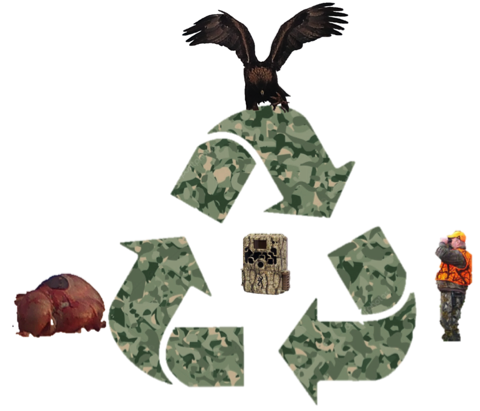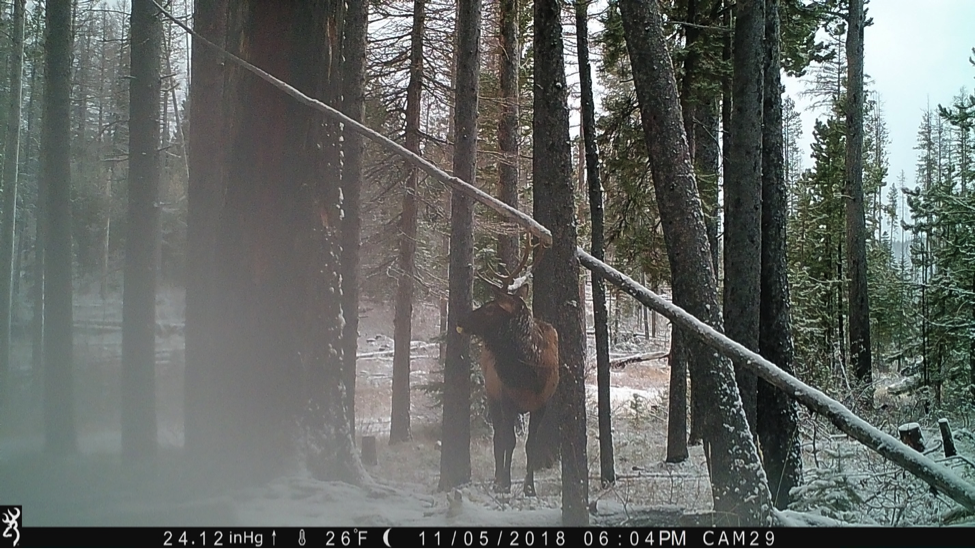
Love triangles caught on camera!
Block title
 By: Mike McTeeResearcher
By: Mike McTeeResearcherMammals
We seek to understand the distribution and abundance of mammals. Several monitoring projects are underway.
Elk- Elk numbers fluctuate through the year with herds of several hundred animals moving onto the ranch in the fall and winter. Fewer elk stay around to raise their calves in the spring and summer. We track herd size, the habitat they use for feeding, and the amount of biomass available to them for forage. We are curious about how elk habits will change in response to changes in vegetation communities as restoration activities proceed.
Bears- The lower elevation draws and drainages at MPG were de-vegetated by herbicide applications and sheep and cattle browsing. As of the summer 2012, we have planted more than 30,000 trees and shrubs in these drainages. The plantings will provide cover for animals using the draw bottoms as travel corridors between the upland forests and the floodplain forests. Many of the shrubs we have planted, such as hawthorns, choke cherries, and serviceberry, will provide food for bears. Our bear monitoring efforts seek to document how many bears we have now and where they travel.
Click here for a link to a list of mammals we have seen and photos.
Click here for links to our best mammal footage.
We would like to do more small mammal research. Please contact us with ideas for collaboration. (Click here to contact us.)
Last fall, we asked hunters to carry game cameras in the field as they hunted. If they left a gut pile, carcass, or butchering scraps, they could deploy the camera to see which scavengers they fed. We presented preliminary results in November, but since then, we’ve dug into the rest of the photos.
Before we bite into the results, if you would like to participate this upcoming fall, drop us a line at [email protected]. We are relying on hunters like you to help push this research forward.
To offer a taste of what your gut pile might attract, here is a time lapse of a wolf pack feasting on the leftovers from a bull elk.Who showed up?
We monitored 16 carrion piles during the 2018 hunting season. The carrion consisted of gut piles, carcasses, or butchering scraps. We tallied 16 scavenger species. An average of 3.8 scavenger species visited each carrion pile carcass. The number of scavenger species ranged from one to six. Black-billed magpies and coyotes visited the most carrion piles, appearing at 15 and 11 of them, respectively. Black-billed magpies also arrived first at the scene 81% of the time.
Scavengers fully consumed carrion in an average of six days after the camera deployment, although this time varied drastically. At two locations, scavengers ate the whole gut pile in one day. In the instance where the wolf pack appeared, the elk carcass lasted 17 days.
Butchering scraps were legally dumped twice. In one case, an antelope’s ribcage was left in the forest. Among the usual suspects that turned up, a black bear and several golden eagles made appearances too. In the second case, scraps were dumped in a backyard surrounded by pasture, where a hen chicken, racoons, and a skunk scavenged.
Scavengers often returned to the site of the carcasses after it had been fully consumed. Magpies poked their bills between grasses, potentially gleaning tiny nuggets of fat and scraps. Mammals investigated too. We saw coyotes, foxes, and a bear sniff the red-tinted soil. Several cameras remain in the field and will help us understand how long scavengers visit the sites after the carrion has been eaten.
Guts in Grasslands: A story of coyotes, magpies, and talon slinging
Gut piles that sat in grasslands always attracted coyotes and magpies. On one occasion, common ravens and a golden eagle appeared. The golden eagle ate a large portion of the liver before brawling with coyotes. When guts were left in sagebrush habitats, scavenger richness often increased, and we also saw golden and bald eagles, a black bear, and a fox. When we pooled data from grassland and sagebrush habitats, the average scavenger richness at each carcass was 2.6.
Forest Riches
Gut piles and carcasses left in the forest tended to be visited by more species of scavengers than those left in grasslands. We observed an average of five species per carcass in forested areas. Game cameras in the forest caught species not detected elsewhere, including bobcats, gray and Steller’s jays, a long-tailed weasel, unidentified rodents, and gray wolves.
Other Curiosities
Two participating hunters became vigilantes. While sneaking through the woods, they found a pile of apples. They figured someone was illegally baiting deer and elk, so they strapped a game camera to a tree in hopes of photographing the lawbreaker. After they left, they called the local game warden. The warden already knew about the apples. In fact, he had set up a game camera there too! The hunters didn’t catch the apple dumper, but they did capture of a bull elk crunching into a Granny Smith.
Elsewhere, a fellow Missoulian was hiking on a nearby mountain and found a dead mule deer. It appeared that a mountain lion had killed it. The hiker knew about our project (he was a hunter too), so he contacted us to see if we would be interested in monitoring the carcass with a game camera. The cat evaded the camera’s detection most of the time, but we did get one great video.
Remember, we’d love you to help us with this work. You can reach us at [email protected].

About the AuthorMike McTee
Mike McTee is a researcher at MPG Ranch and the author of Wilted Wings: A Hunter’s Fight for Eagles.
Mike shot his first weapon before he could recite the alphabet. Now, understanding weapons is part of his job. His career took this trajectory after Mike gained a B.S. in Environmental Chemistry. Curious about potential pollution at a historic shooting range at MPG Ranch, he earned an M.S. in Geosciences studying the site. Strangely, the sulfur inside the trap and skeet targets posed the main threat, not the lead in the shotgun pellets. Regardless, lead contamination soon grabbed Mike’s focus. Each winter at MPG Ranch, biologists caught eagles that had lead coursing through their veins. Lead can cripple eagles flightless and even kill them. Mike soon initiated studies on scavenger ecology and began investigating the wound ballistics of rifle bullets, the suspected source of lead.
Mike often connects with the public through his writings and speaking engagements, whether it be to a local group of hunters, or a gymnasium full of middle schoolers. He frequently writes about the outdoors, with work appearing in Sports Afield, The Drake, and Bugle. When he escapes the office, Mike explores wild landscapes with his family, always scanning the horizon for wildlife.
Sign up for Montana’s Nonlead Newsletter (see past editions).
Mike shot his first weapon before he could recite the alphabet. Now, understanding weapons is part of his job. His career took this trajectory after Mike gained a B.S. in Environmental Chemistry. Curious about potential pollution at a historic shooting range at MPG Ranch, he earned an M.S. in Geosciences studying the site. Strangely, the sulfur inside the trap and skeet targets posed the main threat, not the lead in the shotgun pellets. Regardless, lead contamination soon grabbed Mike’s focus. Each winter at MPG Ranch, biologists caught eagles that had lead coursing through their veins. Lead can cripple eagles flightless and even kill them. Mike soon initiated studies on scavenger ecology and began investigating the wound ballistics of rifle bullets, the suspected source of lead.
Mike often connects with the public through his writings and speaking engagements, whether it be to a local group of hunters, or a gymnasium full of middle schoolers. He frequently writes about the outdoors, with work appearing in Sports Afield, The Drake, and Bugle. When he escapes the office, Mike explores wild landscapes with his family, always scanning the horizon for wildlife.
Sign up for Montana’s Nonlead Newsletter (see past editions).






















